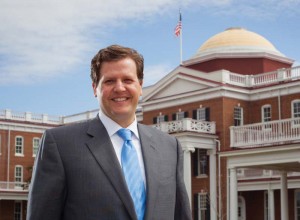 There’s a lot of talk these days about drastic change in higher education, that bricks-and-mortar college campuses will soon go the way of the corner record or book store—unsustainable spaces rendered irrelevant by technology. Here’s my advice: Don’t believe it. In fact, my first year at Longwood has only reinforced my strongly held belief that in higher education, place truly matters.
There’s a lot of talk these days about drastic change in higher education, that bricks-and-mortar college campuses will soon go the way of the corner record or book store—unsustainable spaces rendered irrelevant by technology. Here’s my advice: Don’t believe it. In fact, my first year at Longwood has only reinforced my strongly held belief that in higher education, place truly matters.
That’s especially true here at Longwood, where we enjoy a distinctive camaraderie rooted in our 175 years of history, our unique traditions, and our commitment to human-scale teaching and learning. We draw inspiration from the classical architecture of buildings like Ruffner and French. Students and faculty converse not just in classrooms and the library, but also along Brock Commons or over meals in the dining room. Our citizen leaders learn from mentors, and one another, in residence halls and on playing fields, performance stages and grassy lawns.
Our committed faculty and staff are our greatest resource, but the “place” of Longwood is a treasure most colleges in America would envy, and we must be careful stewards. Over the coming year, Longwood will be working with Cooper Robertson, a nationally known architecture and planning firm, to undertake a new campus master plan. Longwood’s first master plan was completed in 1965, and our most recent in 2008. That wasn’t so long ago, but much of the construction envisioned in the last plan is moving through the pipeline. We’ve also grown a bit, and we are just finishing up a new strategic plan, which will provide clear direction regarding the place we want to become.
The finest American college campuses are great because they plan carefully and far in advance—and we must be looking to 2025 and beyond. Thoughtful master planning is the best way to focus our resources and to ensure our campus functions efficiently and sustainably, meets our needs and fits together in a harmonious manner that will inspire our next generations of students.
My marching orders as we begin this process are: “Longwood will be the same, but better.” We want to maintain and improve upon our character as a strong residential community. Our beautiful architectural history must be honored. And Longwood should become more of a destination, a place where alumni and other visitors will want to return to again and again.
A key focus will be knitting together the campus and the Farmville community. There is a tremendous opportunity for a greater and more vibrant flow of students and residents between campus and Main Street. We’ll be looking carefully at these issues through the lens of “new urbanism”—an architectural approach that emphasizes improving the vibrancy of a community by making it more walkable, welcoming and inviting. Farmville has great potential as a college town, and helping it reach that potential is critical for Longwood to attract and retain students, faculty and staff.
Over the coming year, this planning process will entail many conversations with the Longwood community. We welcome your ideas. The end result will be an energizing blueprint for what this place can be and a vision that we will excitedly begin to see take shape in the years ahead.
Thank you and my best,
W. Taylor Reveley IV
President

